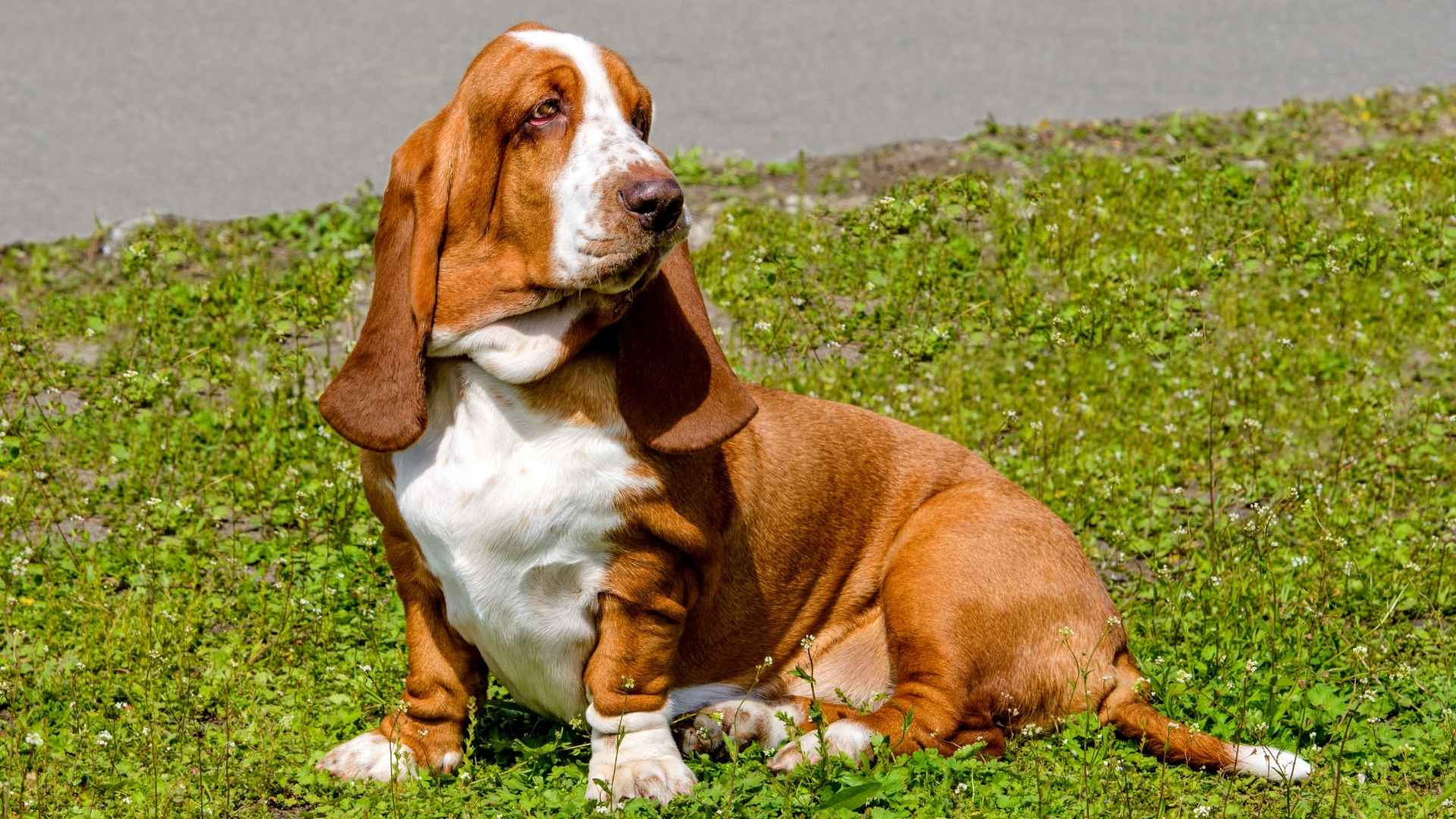With their endearing expressions and signature ear flops, floppy-eared dog breeds have a way of tugging at our heartstrings like few others. Whether it’s the soulful gaze of a Cocker Spaniel or the dramatic droop of a Basset Hound’s ears trailing the floor, these dogs are as charming as they are recognizable. Often associated with softness and approachability, floppy ears give certain breeds a perpetually puppy-like appearance, one that dog lovers can’t resist.
But those long, pendulous ears aren’t just for show. While scientists continue to debate the origins of floppy ears, some linking them to domestication and selective breeding, there’s a practical function behind the form. For many breeds, especially trackers, floppy ears help trap and channel scent particles toward the nose, making them exceptional at sniffing out trails and scents. In essence, their ears enhance one of their most powerful senses.
From loyal hunters to devoted companions, floppy-eared breeds offer more than just adorable aesthetics. They represent a blend of utility, personality, and timeless cuteness that makes them favorites in homes and hearts around the world.
Floppy-Eared Dog Breeds
1. Basset Hound
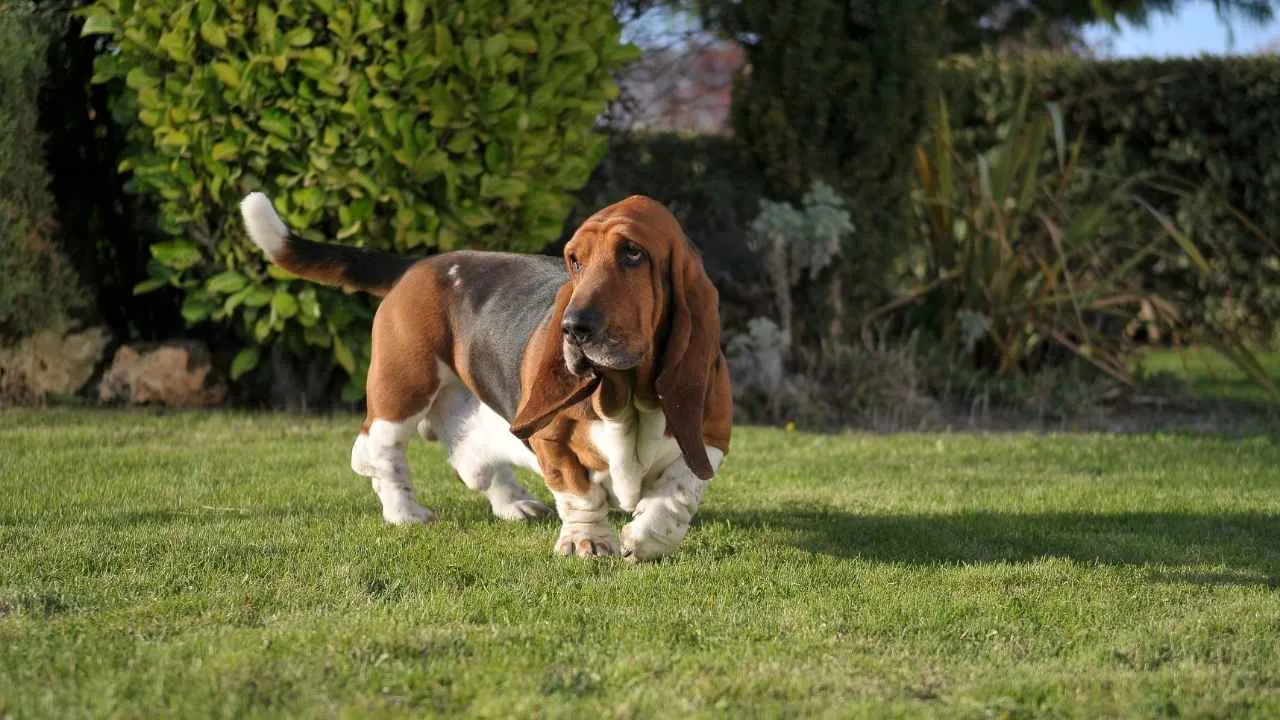
The Basset Hound is the quintessential floppy-eared dog, known for its soulful eyes, droopy face, and famously long ears that nearly sweep the ground. Britannica reports that the Basset Hound is commonly known for its lazy demeanor.
Originally developed in France as a scent hound for tracking rabbits, the Basset Hound remains one of the most powerful sniffers in the dog world. Standing no taller than 15 inches and weighing between 40 to 65 pounds, this low-slung, heavy-boned breed boasts surprising stamina and strength despite its leisurely pace.
Its distinctive features include a domed skull, muscular legs, wrinkled brow, and thick paws built for endurance rather than speed.
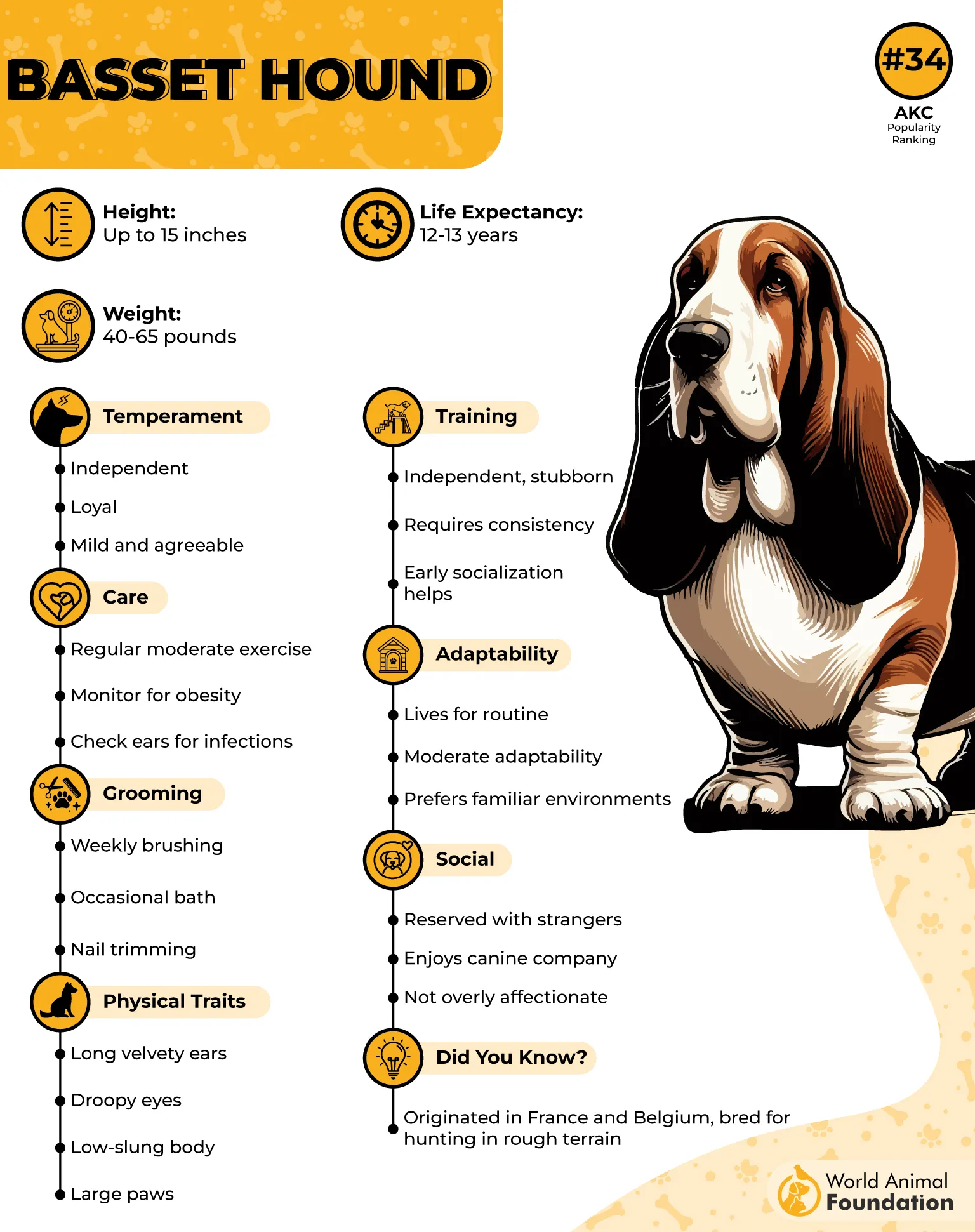
Grooming
Though their coat is short and smooth, Basset Hounds are moderate to heavy shedders. Weekly brushing is essential to remove dead hair and maintain healthy skin.
Their long ears require regular cleaning to prevent infections, and their wrinkled skin benefits from occasional wiping to avoid irritation. Due to their droopy build, attention to hygiene, especially around ears and skin folds, is key to keeping them comfortable and clean.
Fun fact: Relative to their size, Basset Hounds have heavier bones than any other dog breed, giving them impressive strength beneath their charming, laid-back exterior.
2. Beagle
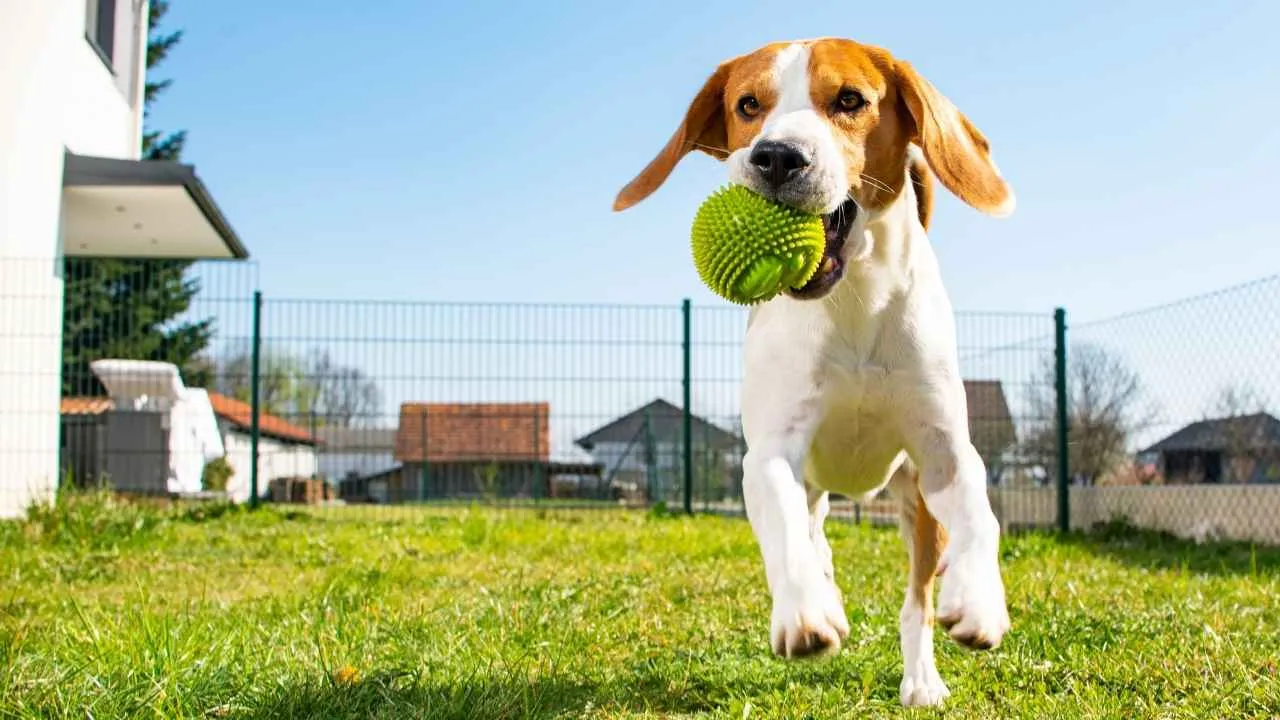
Known for their cheerful demeanor and signature floppy ears, Beagles are small hounds with an impressive tracking ability and a heartwarming presence. Historically emerging in the United States before the Civil War, this breed was officially recognized by the American Kennel Club in 1885.
Today, Beagles come in two size varieties: those standing under 13 inches and those between 13 and 15 inches tall, typically weighing between 20 to 30 pounds. With their strong hunting instincts and “nose on paws” reputation, Beagles thrive on scent-driven activities and outdoor play.
Purina states that Beagles are loving, intelligent, and full of energy. Their iconic ears not only enhance their endearing appearance but also serve a functional purpose by helping funnel scents directly to their powerful noses.
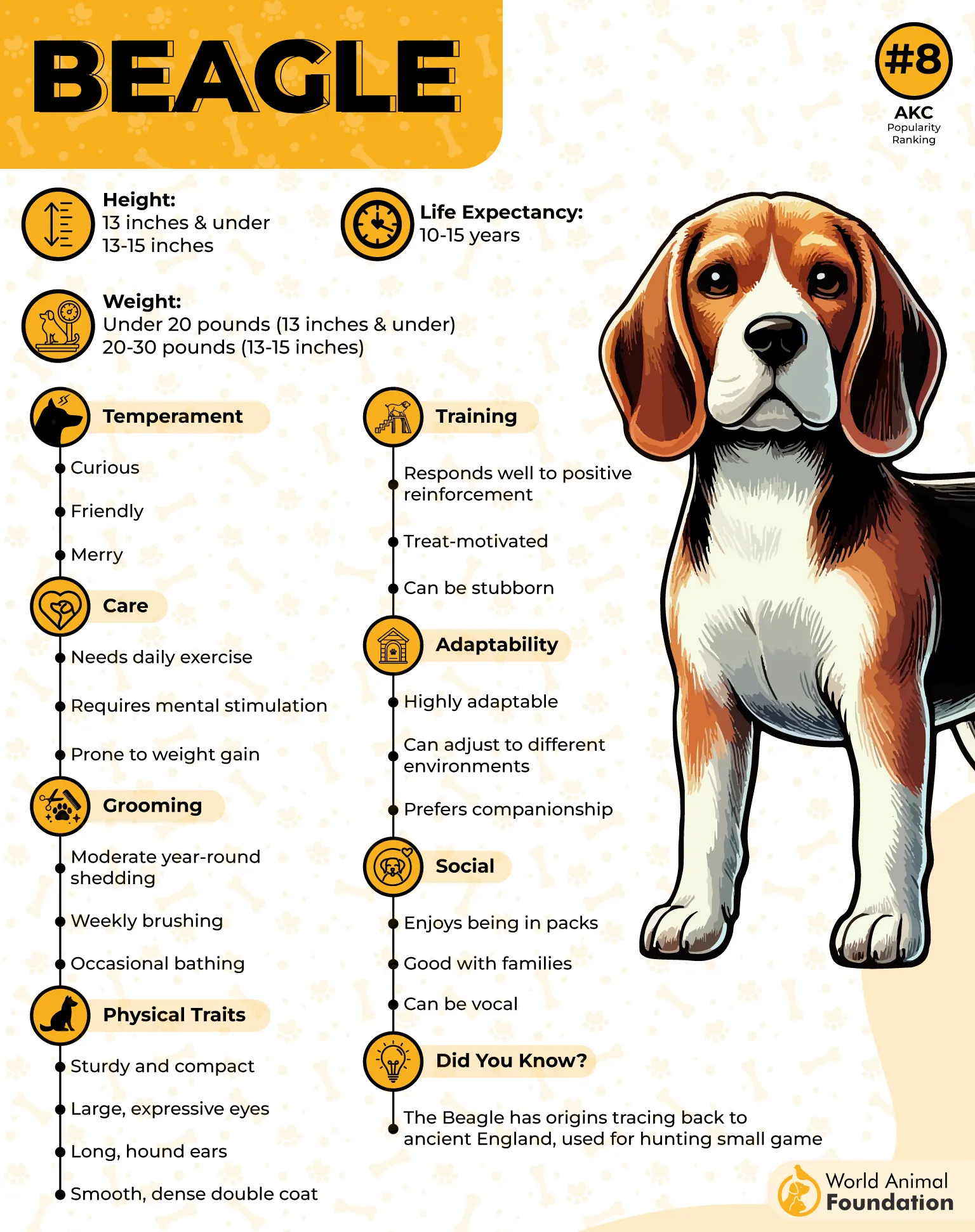
Grooming
Beagles have a dense, coarse double coat that sheds consistently year-round. While shaving is generally discouraged due to potential long-term coat damage, regular brushing at least twice a week helps control shedding and maintain coat health.
Owners often struggle with embedded hairs on furniture or clothing, which can feel stiff and uncomfortable. High-quality deshedding tools and a steady grooming routine, without trimming or shaving, are the best approach to keeping their coat manageable.
Fun fact: One of the most famous Beagles in history is Snoopy from the “Peanuts” comic strip, introduced by Charles M. Schulz.
3. Dachshund
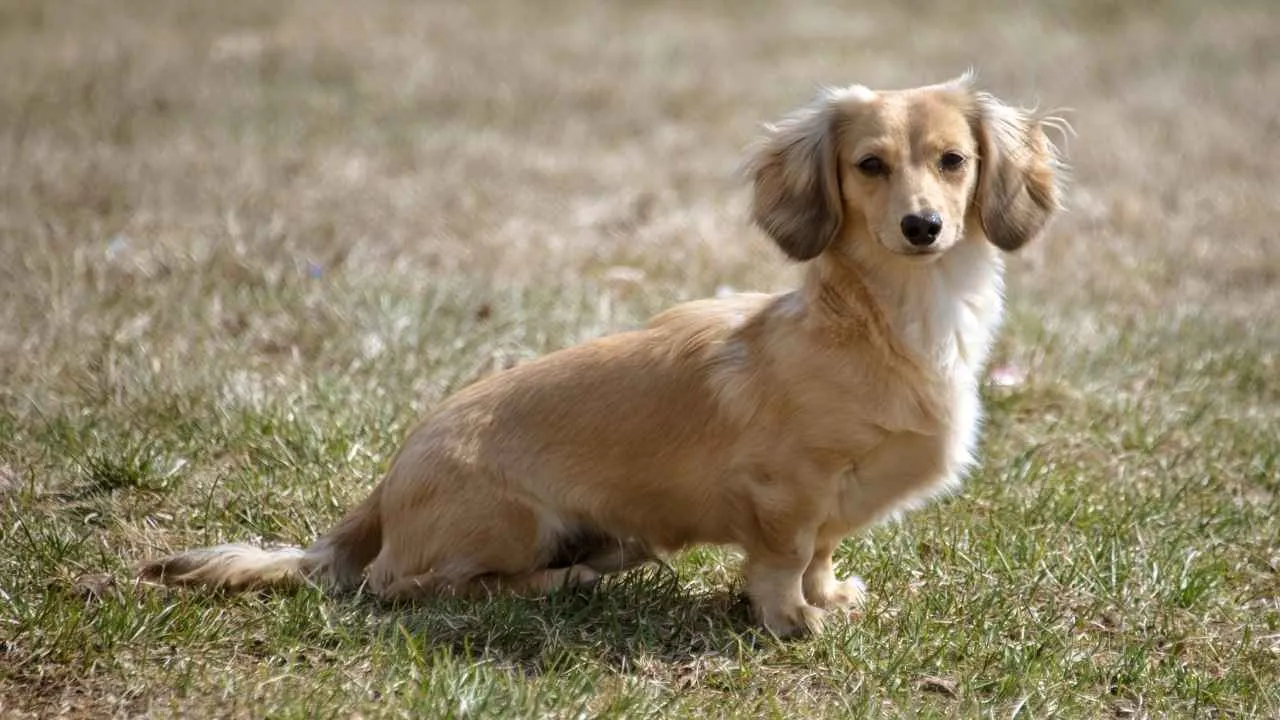
Nicknamed the “wiener dog,” the Dachshund is one of the most easily recognized floppy-eared breeds. WebMD notes that Dachshunds are a playful and well-loved breed known for their bold and lively personality.
Originally bred in Germany in the 17th century to burrow into badger dens, the name “Dachshund” literally translates to “badger dog.” These compact canines come in two sizes, standard and miniature, ranging from 16 to 32 pounds, with a height between 8 and 9 inches.
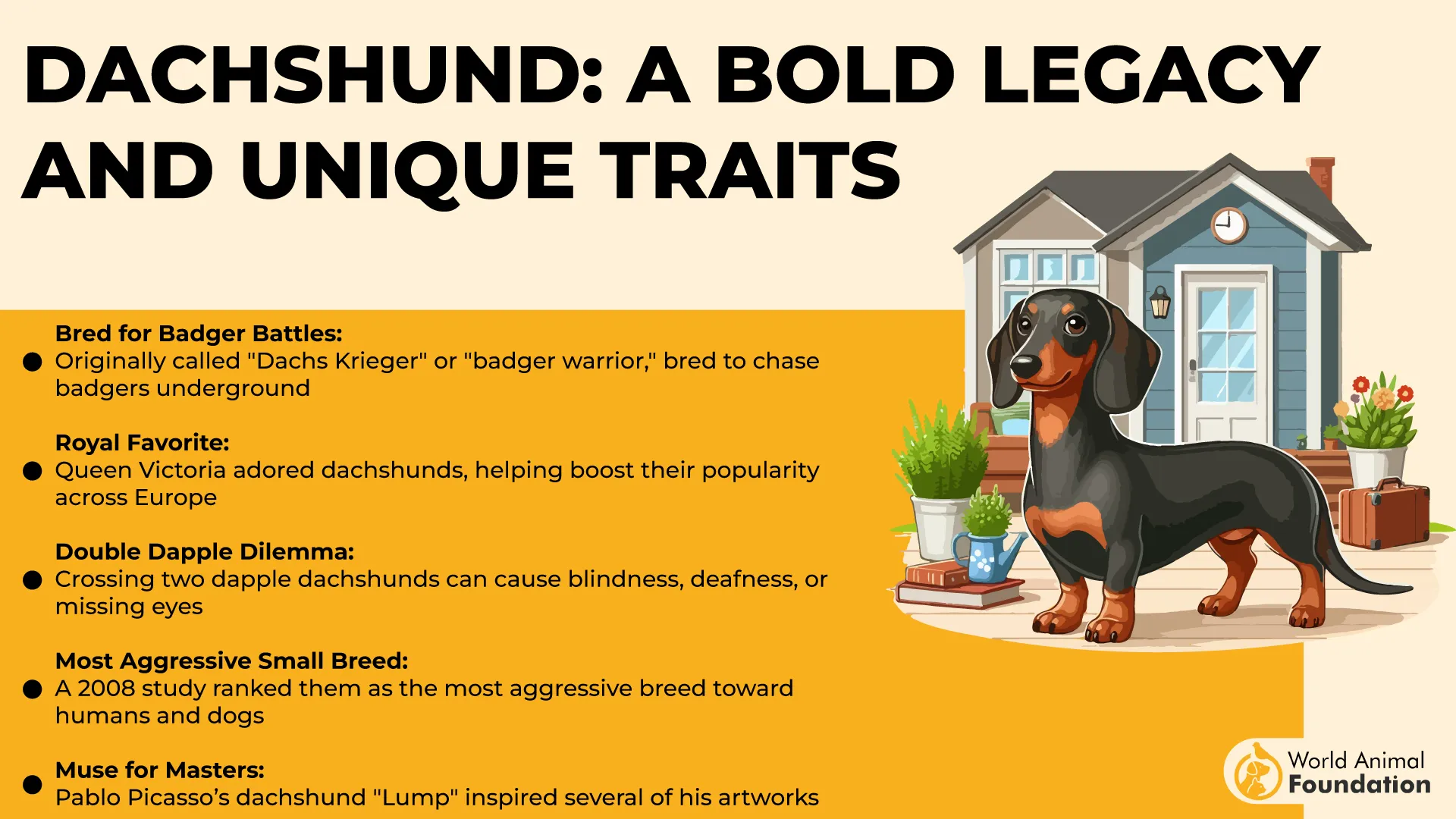
Despite their small stature, they’re known for their bold, confident personalities and high prey drive. Their elongated backs, short legs, and expressive, floppy ears give them an unmistakable silhouette that’s both charming and iconic.
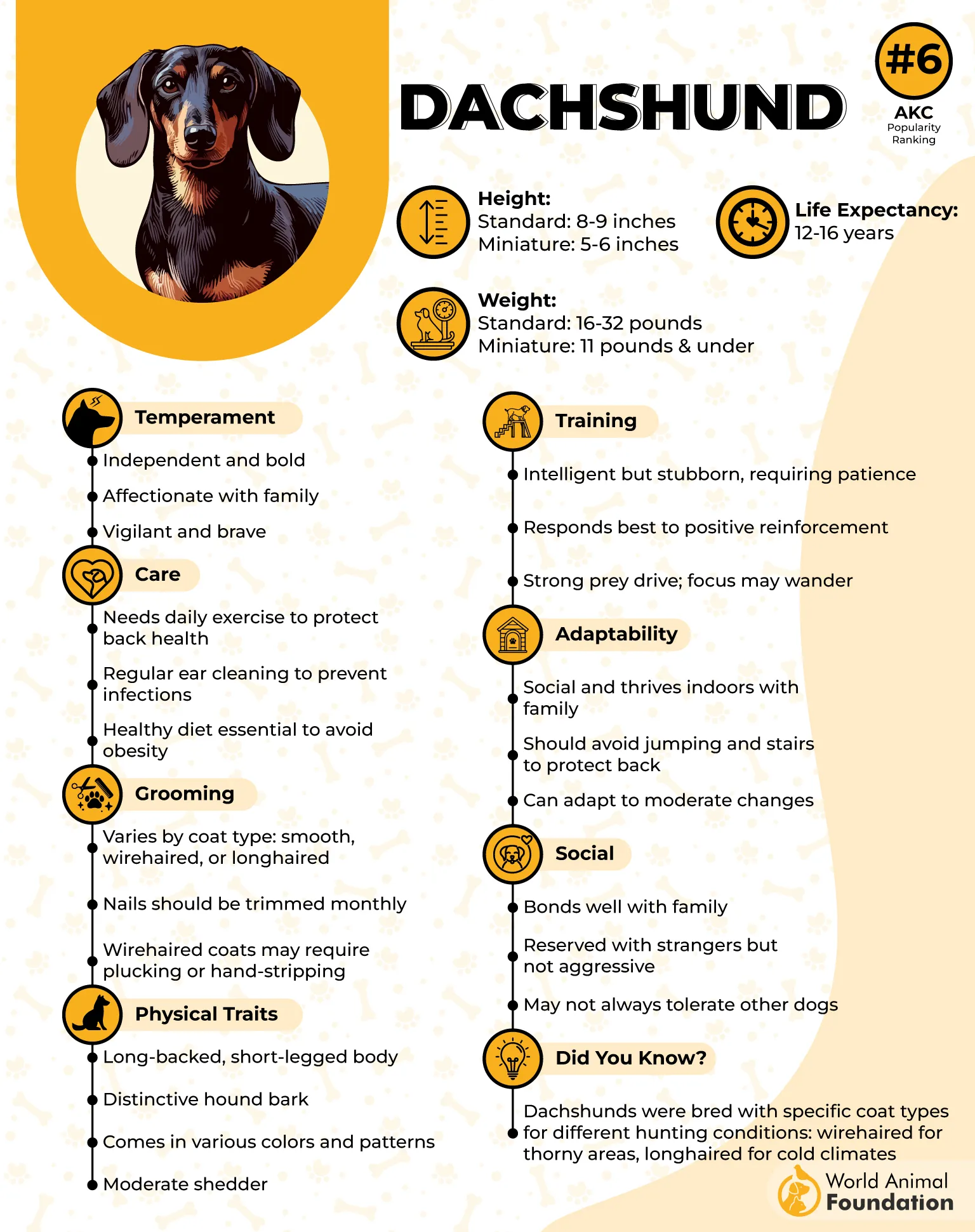
Grooming
Dachshunds come in three coat types, smooth, longhaired, and wirehaired, each with its own grooming needs. Wirehaired Dachshunds benefit from regular brushing with a firm bristle brush to reach the skin beneath and stimulate oil production.
Gentle yet firm pressure during grooming helps keep their double coat healthy and free of dead skin. Regular ear checks are also essential, as their low-hanging ears can trap debris and moisture, increasing the risk of infections.
Fun fact: Dachshunds were officially recognized by the American Kennel Club in 1885, and their quirky, bold nature has made them a household favorite ever since.
4. Golden Retriever
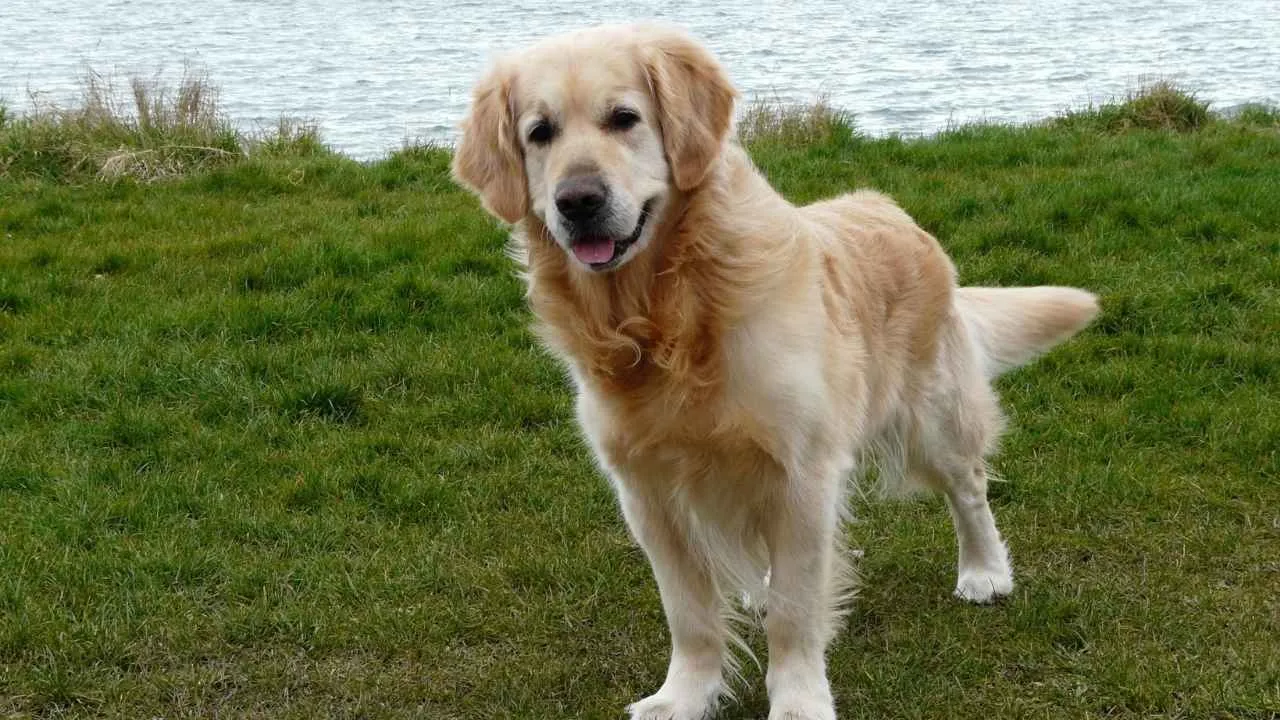
Affectionate, intelligent, and radiating sunny charm, the Golden Retriever has been winning hearts since its official recognition by the American Kennel Club in 1925. Originating from a lineage designed for fieldwork and hunting, this breed balances beauty with brawn.
With males reaching up to 24 inches tall and weighing between 67 to 75 pounds (females slightly smaller at 21.5–22.5 inches and 55–65 pounds), they are muscular and agile. Their warm personality and floppy ears, passed down from hound ancestry, make them beloved family dogs, therapy animals, and standout service companions. It is one of the most popular dog breeds.
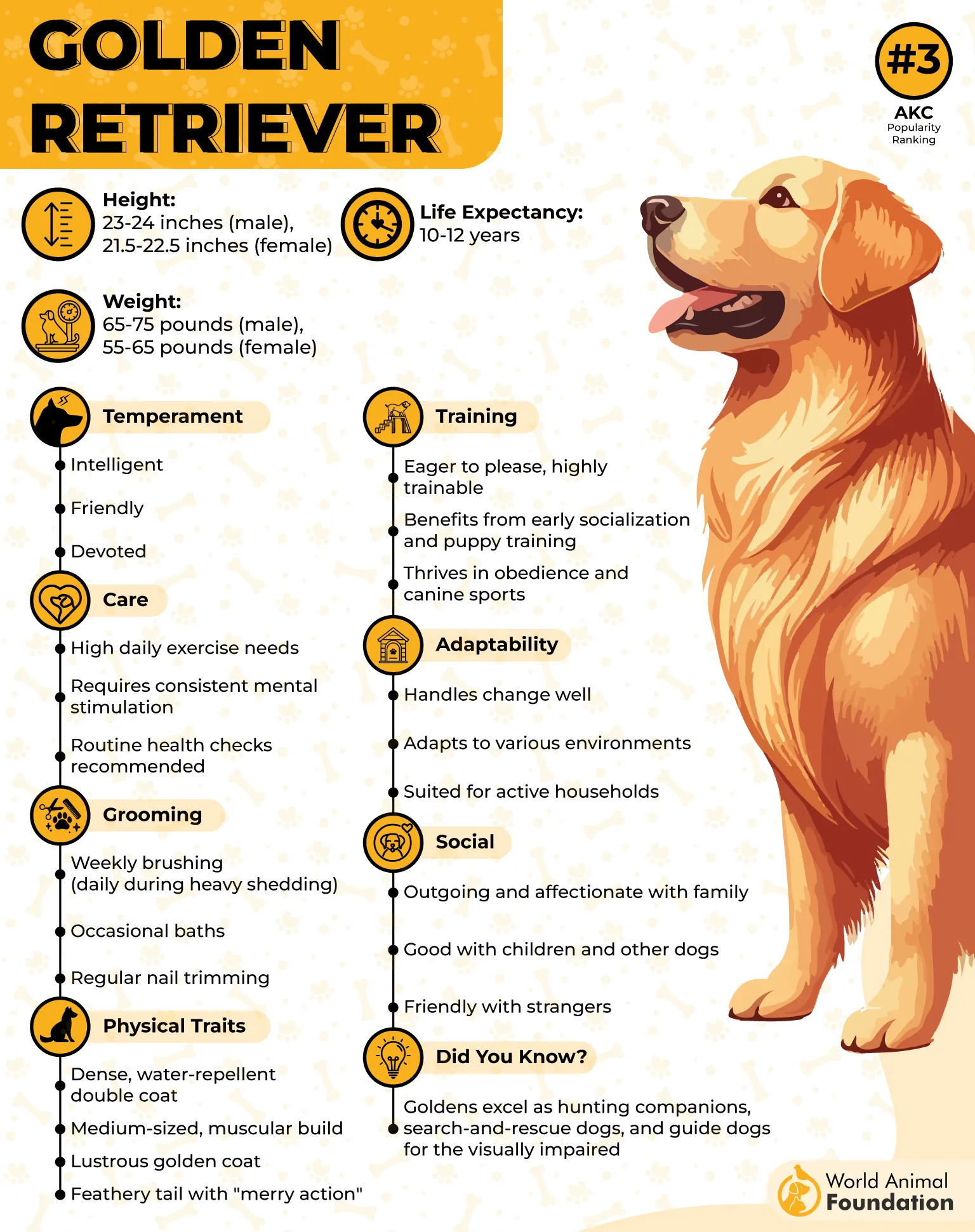
Grooming
Golden Retrievers have a thick, water-repellent double coat that sheds consistently and heavily twice a year. Weekly brushing helps control typical shedding, while daily grooming is ideal during peak molting seasons. Use a pin brush, especially on feathered areas behind the ears, chest, and tail.
Spritzing water or using coat conditioner can ease detangling. Floppy ears, though adorable, need extra attention, especially after swimming, to prevent infections or debris buildup.
Fun fact: Golden Retrievers are so sociable and obedient that they’ve become top choices for guide dog and search-and-rescue work across the globe.
5. Cocker Spaniel
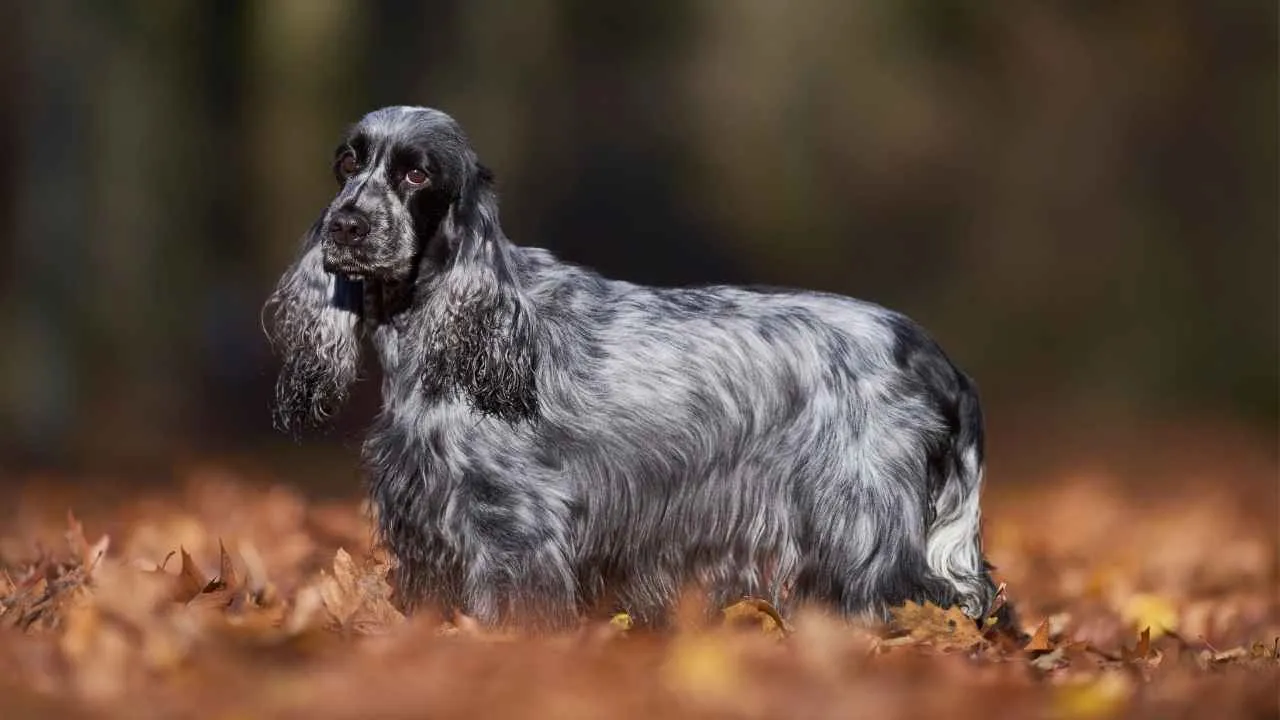
The Cocker Spaniel, cherished for its expressive eyes and signature floppy ears, is a charming breed known for its sweet disposition and devotion to family. There are two main types: the American Cocker Spaniel and the English Cocker Spaniel.
Both boast those iconic long, curly ears and a compact, medium-sized frame. Males typically weigh between 25–30 pounds, while females range from 20–25 pounds.
With roots tracing back to 17th-century Europe, Cocker Spaniels originally hunted birds but are now better known as affectionate companions. Their velvety ears, while adorable, also waft scent particles toward their nose, a feature thought to enhance their already sharp sense of smell.
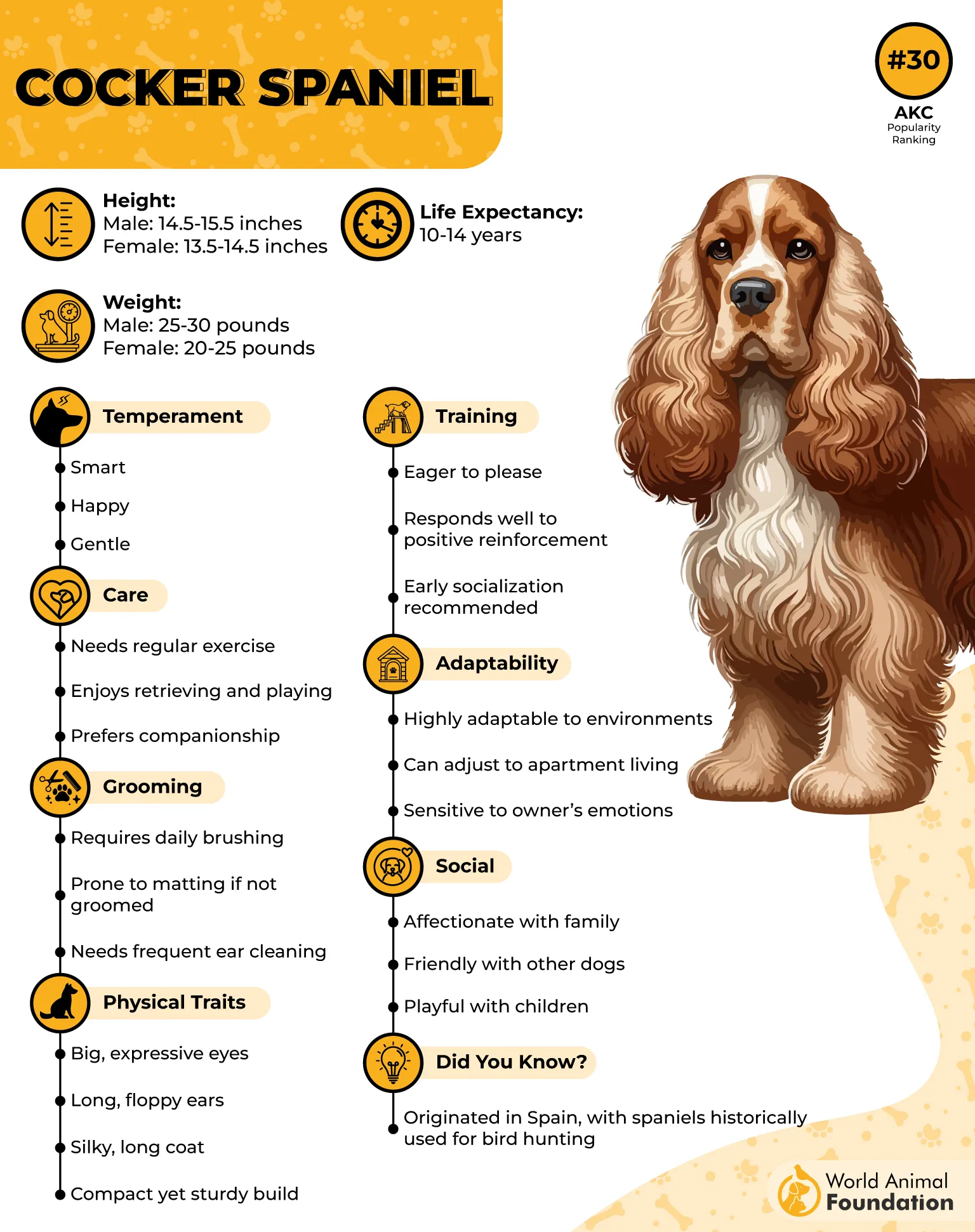
Grooming
Cocker Spaniels have a luxurious coat that requires regular maintenance. Without proper grooming, dead hair can build up, leading to a dull, unkempt appearance, often seen in faded or “ginger” patches. Their signature ears also demand frequent cleaning to avoid infection. Regular brushing and coat trimming are essential to keep these Spaniels looking tidy and healthy.
Fun fact: Disney’s beloved “Lady” from Lady and the Tramp was modeled after a Cocker Spaniel, cementing the breed’s place in pop culture history.
6. German Shorthaired Pointer
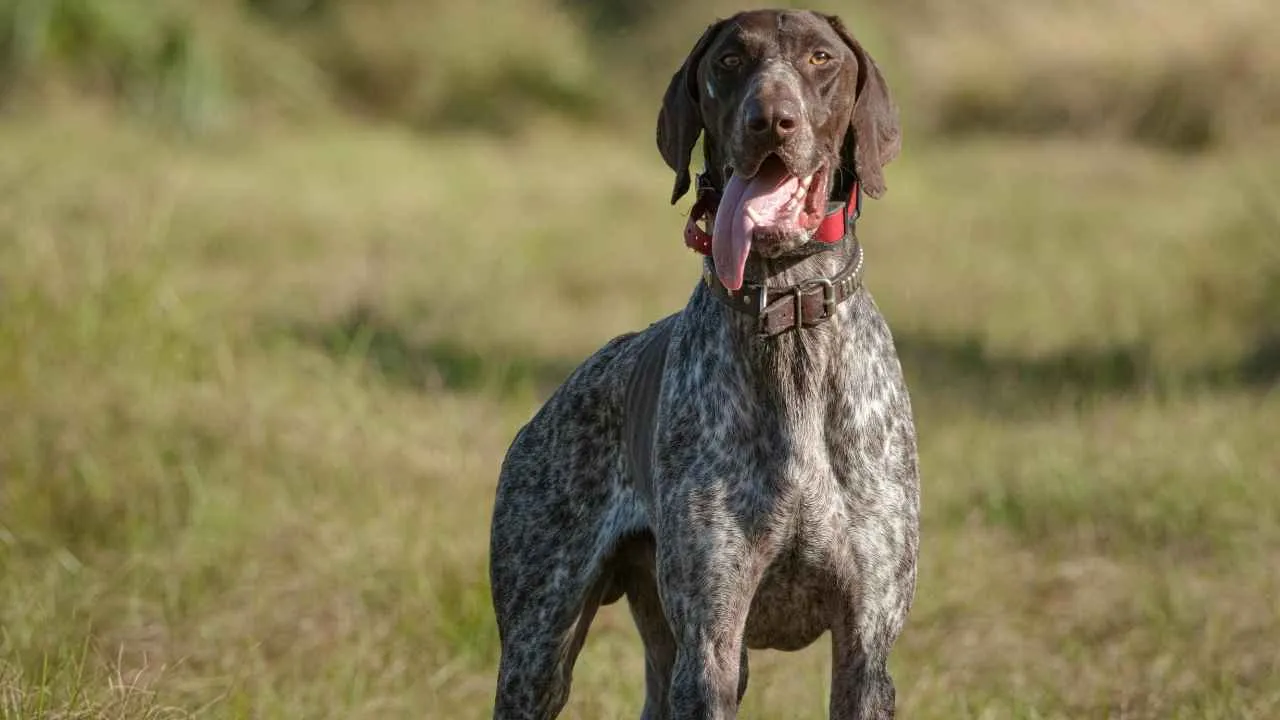
Often celebrated as one of the most versatile sporting dogs, the German Shorthaired Pointer (GSP) excels in everything from tracking to retrieving, both on land and in water. Originally developed in 17th-century Germany, the GSP was bred for endurance, agility, and an eagerness to please.
This medium-sized breed stands between 21 and 25 inches tall and weighs anywhere from 45 to 70 pounds. Known for their lean, athletic build and expressive floppy ears, these dogs are often dubbed the “Swiss Army knives” of the canine world. Their energy is boundless, and they thrive on activity, companionship, and mental stimulation.
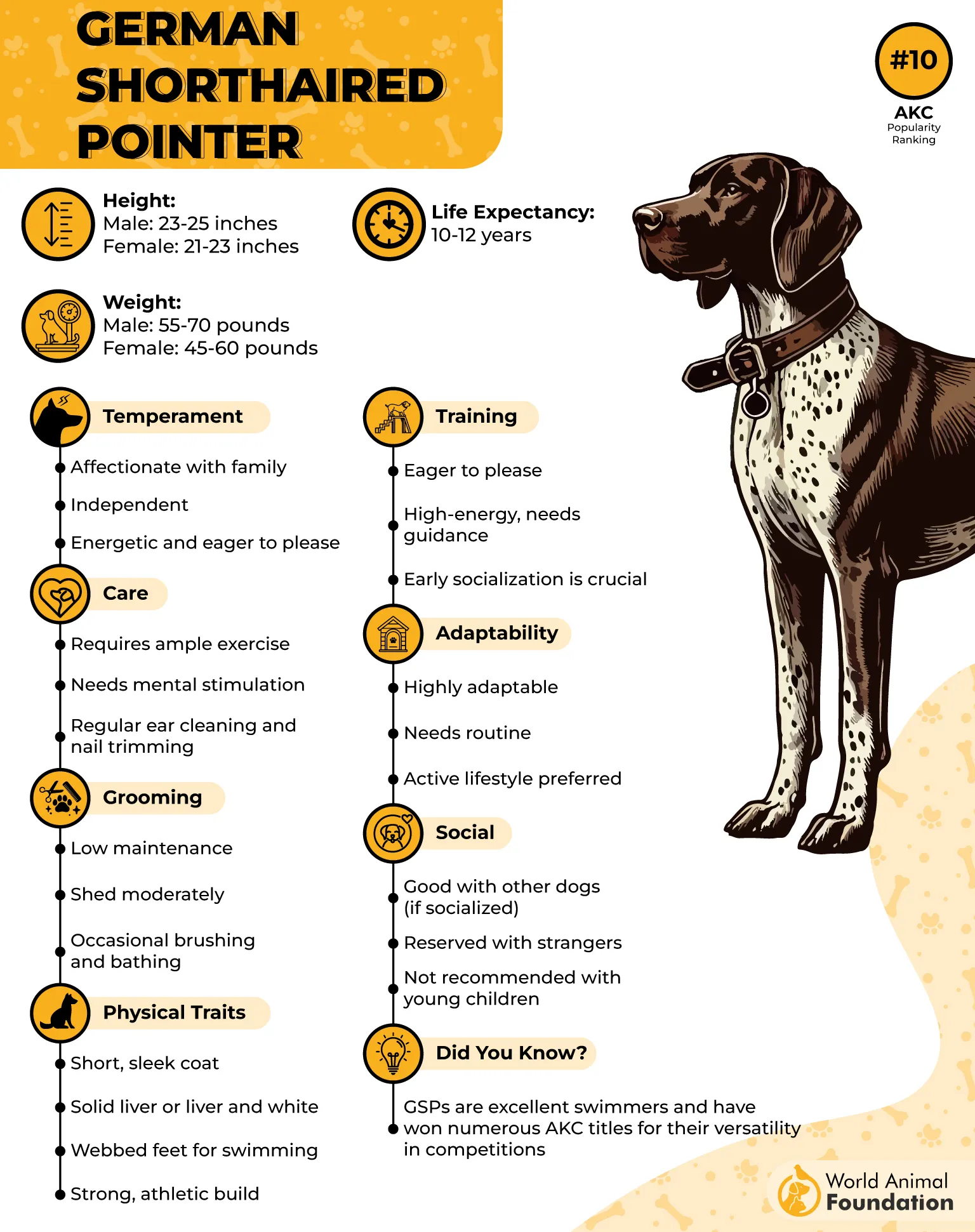
Grooming
The GSP’s sleek, short coat is relatively low-maintenance, requiring only light brushing a few times a week, more during shedding season. Their water-resistant fur helps them dry quickly after a swim, but their floppy ears can trap moisture and debris, making regular ear checks essential to prevent infections. A grooming mitt or soft brush works well to keep their coat clean and healthy.
Fun Fact: The German Shorthaired Pointer was first recognized by the American Kennel Club in 1930 and remains a popular breed for both sport and companionship.
7. Shih Tzu
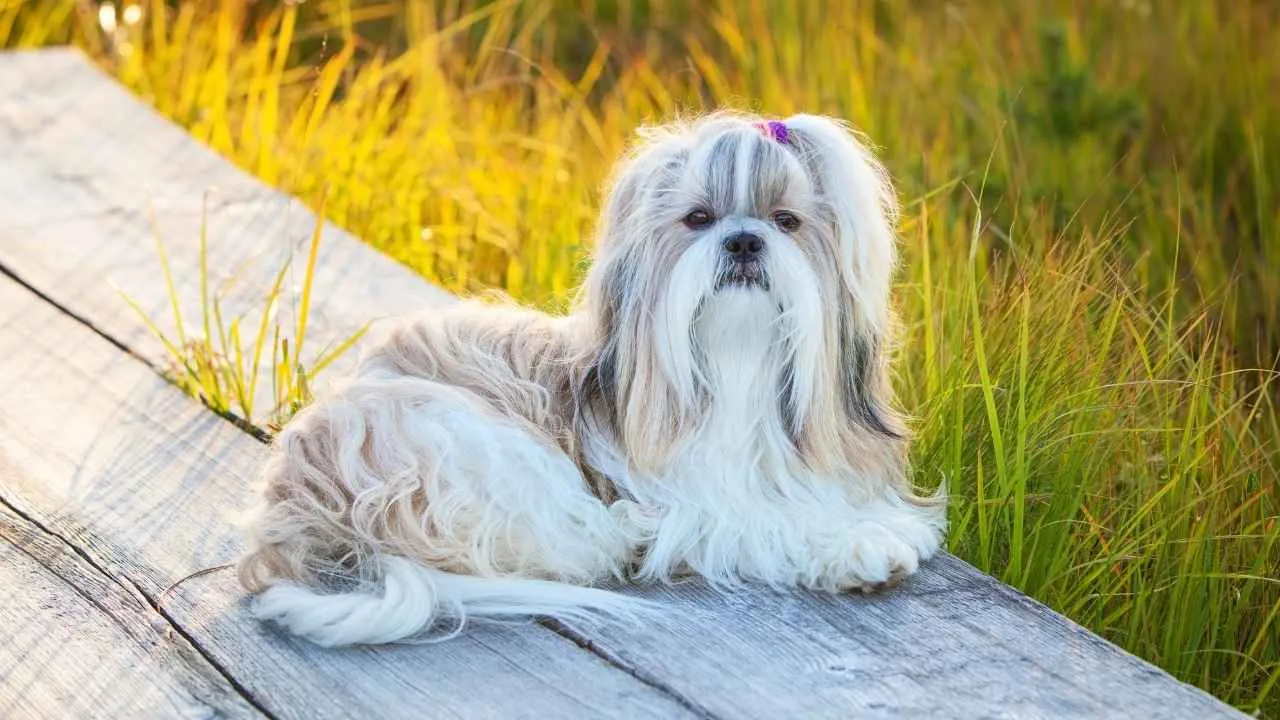
The Shih Tzu, affectionately known as the “lion dog,” is a regal toy breed with roots tracing back over a thousand years to ancient China. Originally bred for Chinese royalty, this compact companion stands between 8 to 11 inches tall and weighs 9 to 16 pounds.
Shih Tzus are instantly recognizable by their distinct underbite, luxurious coat, and soft, floppy ears. Their dense, double-layered coat can be found in a wide range of colors and combinations, including gold, white, black, gray, and red.
The breed was introduced to the United States during the Communist Revolution in China and has since become a beloved lapdog. Prices for a Shih Tzu puppy typically range based on pedigree and breeder.
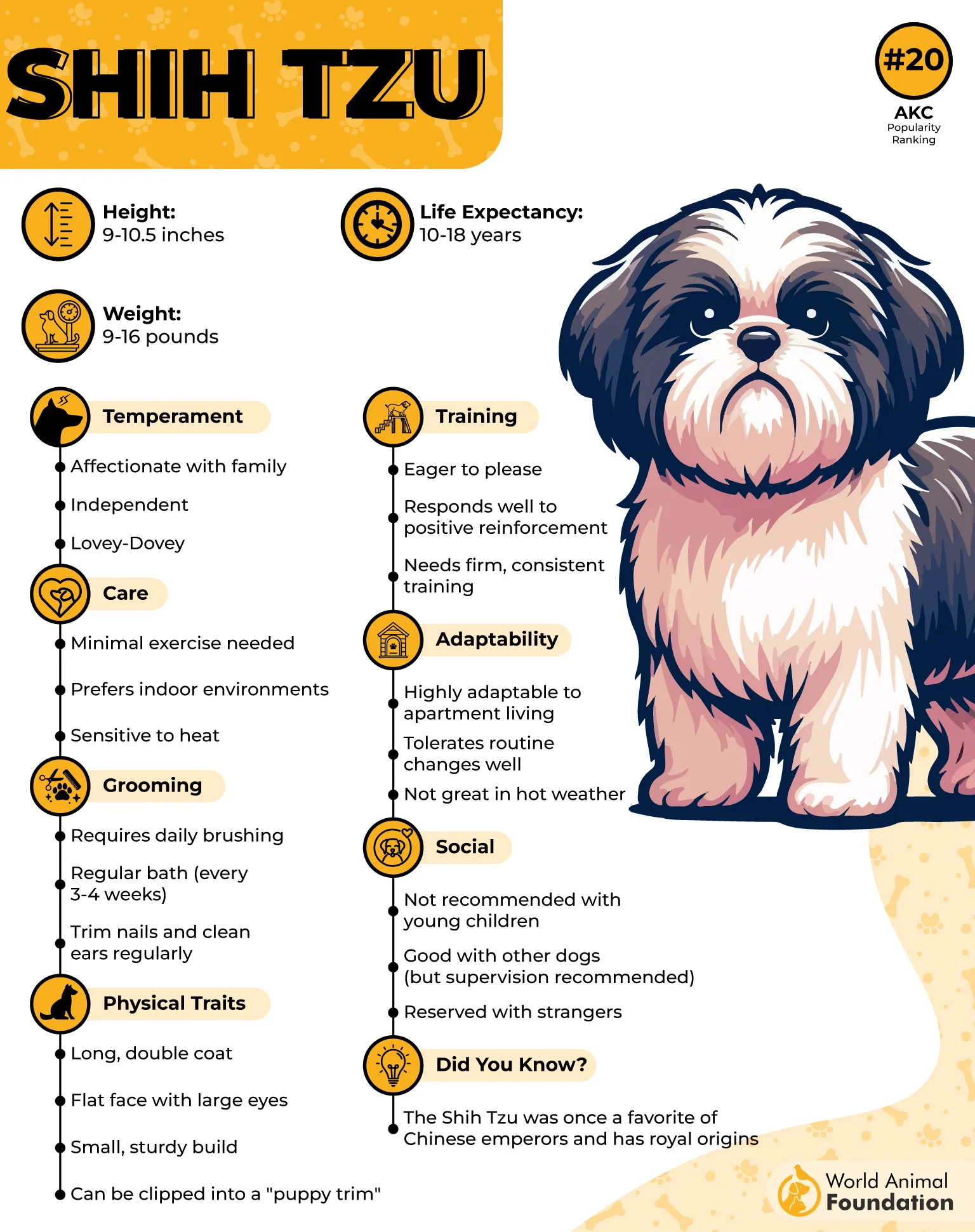
Grooming
Maintaining the Shih Tzu’s flowing coat requires dedication. Their grooming routine includes brushing to prevent tangles, trimming around the eyes, and regular baths. Because their floppy ears can trap moisture and hair, it’s important to clean them frequently to avoid infections.
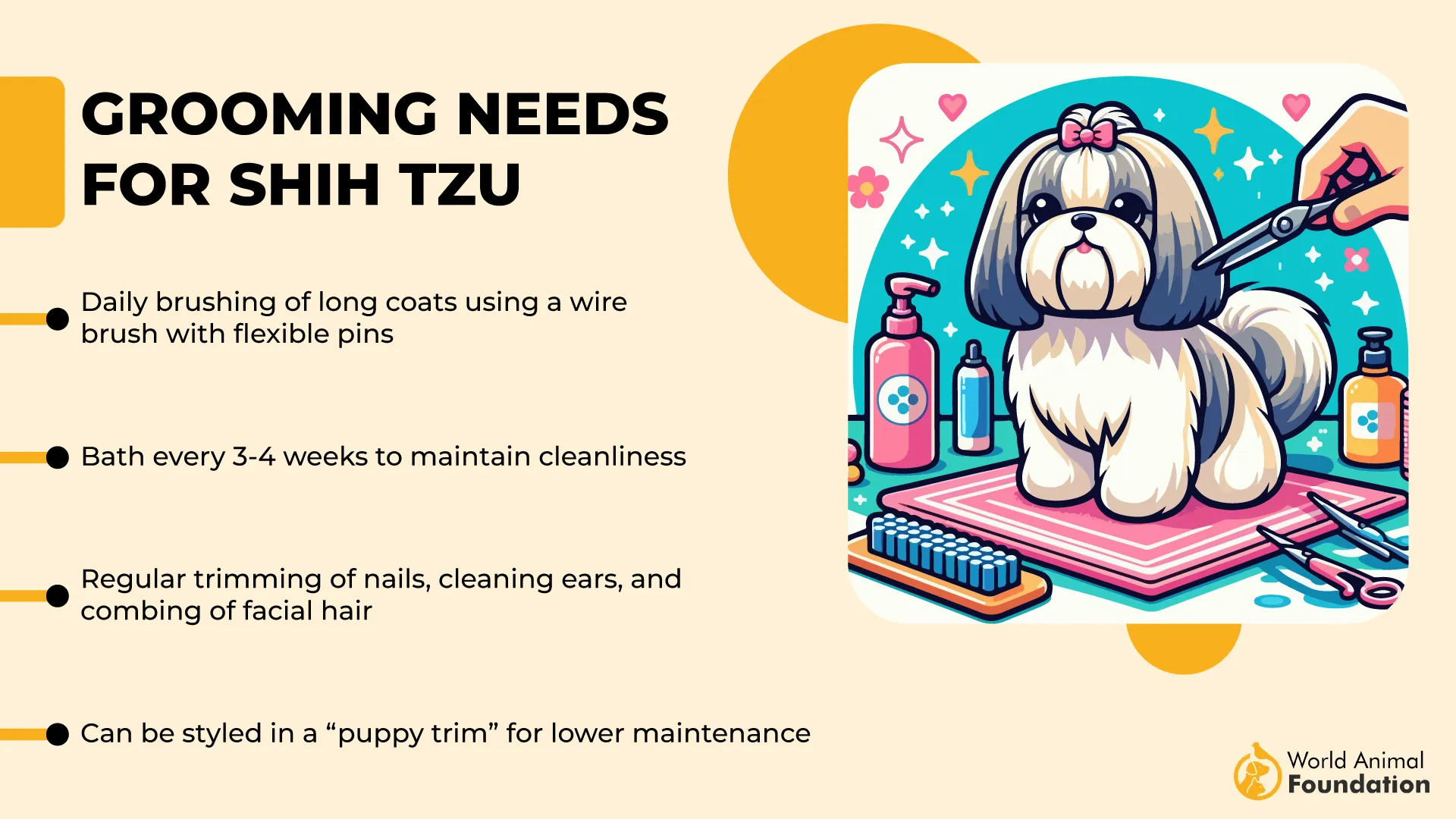
Top knots or short trims around the face are common to prevent eye irritation. Professional grooming often involves steps like pre-shaving and pre-bathing, depending on coat condition.
Fun fact: The Shih Tzu was officially recognized by the American Kennel Club in 1969 as part of the Toy Group.
8. Boxer
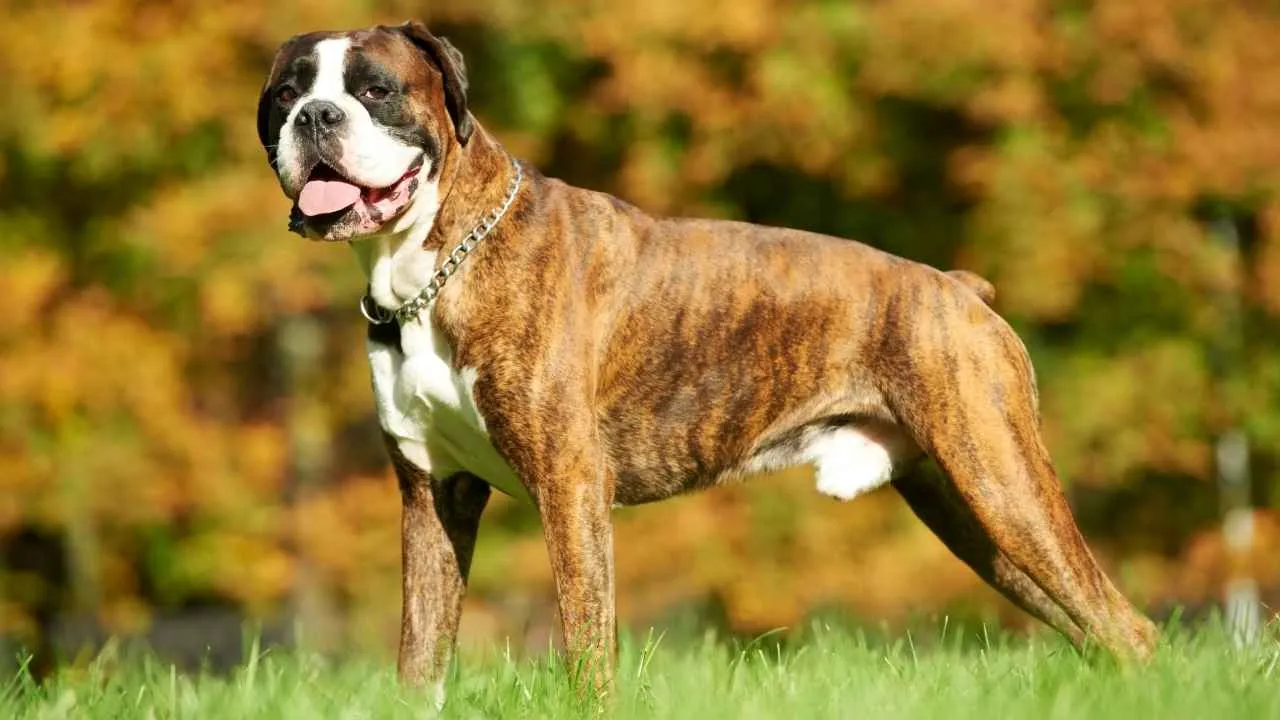
The Boxer, with its unmistakable charm and athletic build, is a breed that blends playfulness with protective instincts. Originally descended from the Old English Bulldog and the Bullenbeisser, Boxers boast a distinct head with a broad, short skull and characteristic underbite.
These medium to large-sized dogs typically stand between 21.5 to 25 inches at the shoulder and weigh anywhere from 50 to 80 pounds, depending on gender.
Known for their naturally floppy ears and soulful, expressive eyes, Boxers are faithful companions, particularly cherished in families with children due to their patience and zest for play. Though some Boxers have erect ears, this results from ear cropping, a practice often debated and mostly cosmetic.
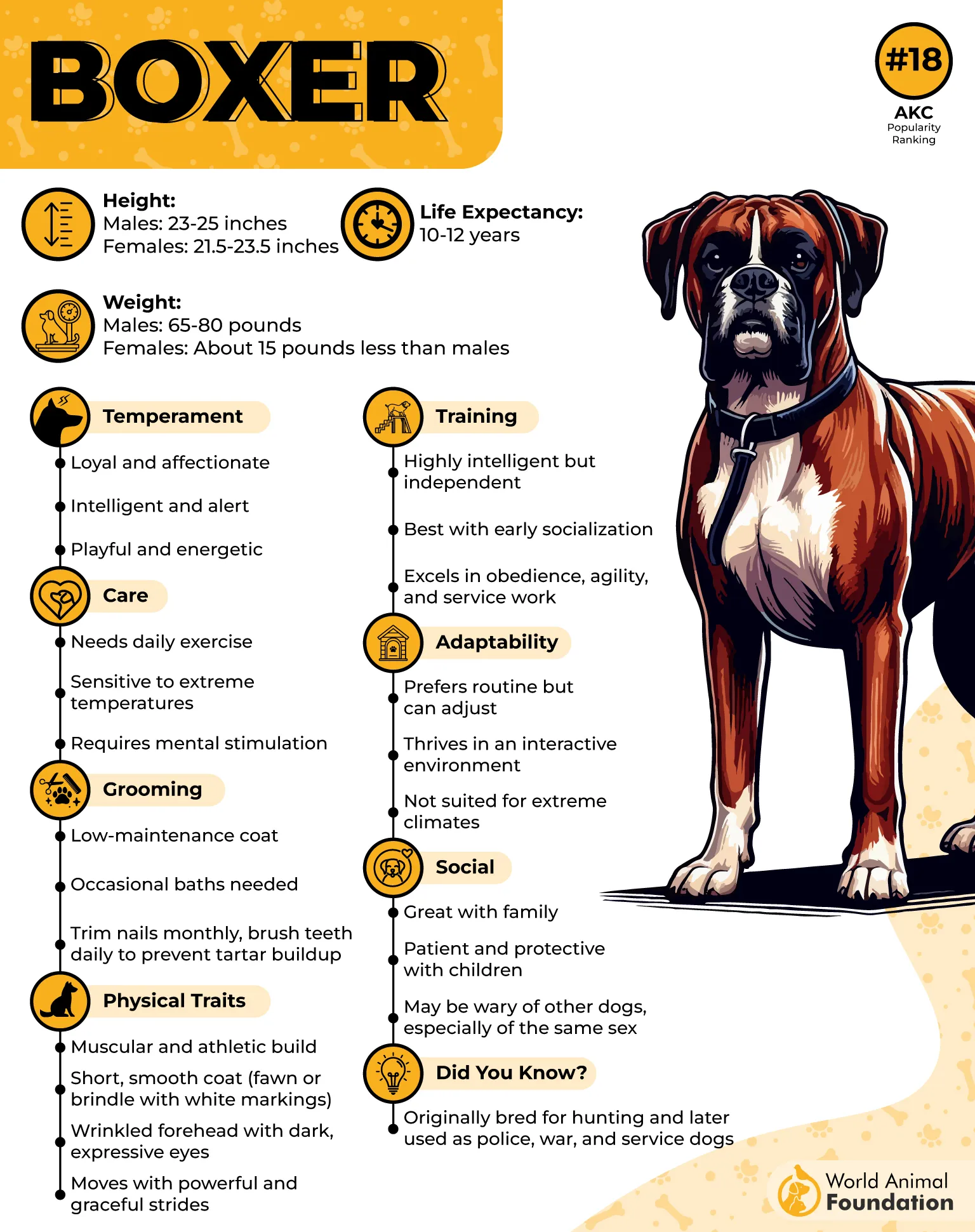
Grooming
Boxers have short, sleek coats that are incredibly low-maintenance. A quick brush once or twice a week with a hound glove or rubber brush helps keep their coat glossy and clean. These dogs are naturally tidy and typically require bathing only occasionally unless they get into something messy.
Fun fact: Despite their strong and stoic appearance, Boxers are notorious for their silly antics and are often described as “clowns” in the dog world for their humorous behavior.
9. Afghan Hound
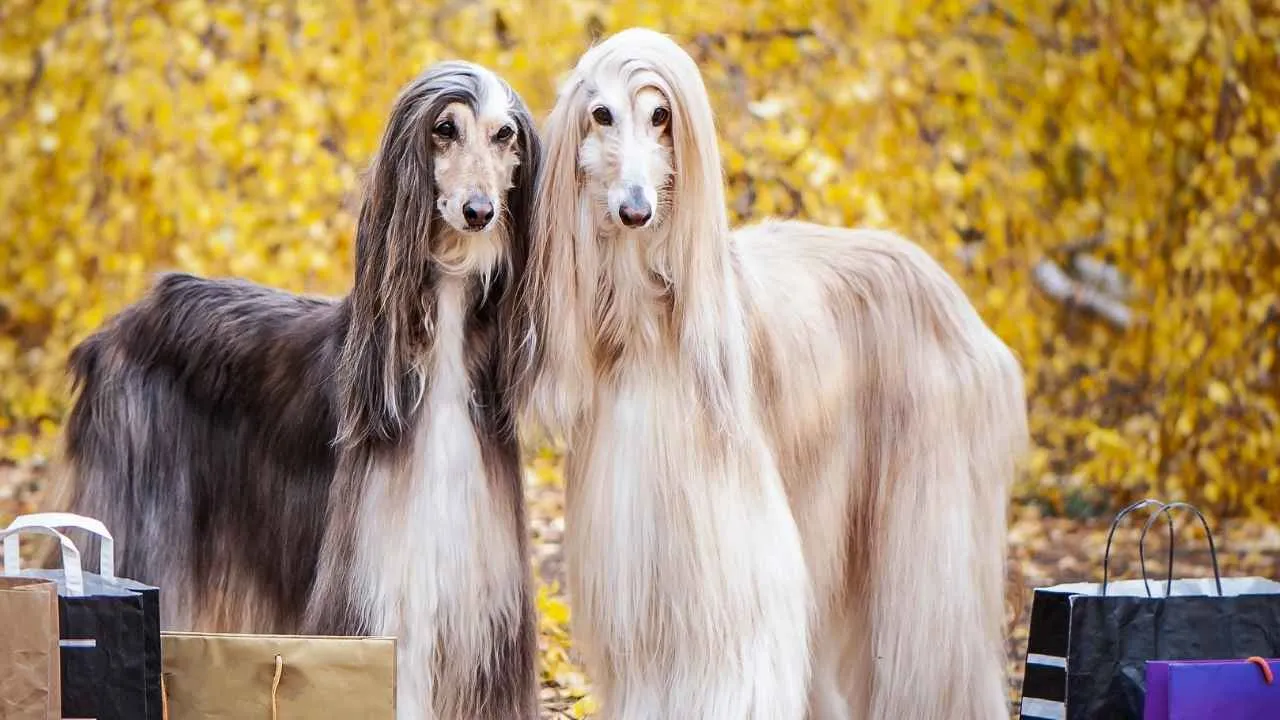
Elegant and ethereal, the Afghan Hound is among the most iconic floppy-eared breeds, known for its flowing, silky coat and aristocratic profile. Originally bred in the rugged terrain of Afghanistan, this ancient sighthound was used to pursue swift prey like leopards and gazelles.
Males typically stand 25 to 27 inches tall and weigh between 50 to 60 pounds. These dogs are instantly recognizable for their long topknots, curved tails, and slender, dignified frames. While independent and often aloof with strangers, Afghan Hounds are fiercely loyal and playful with their families.
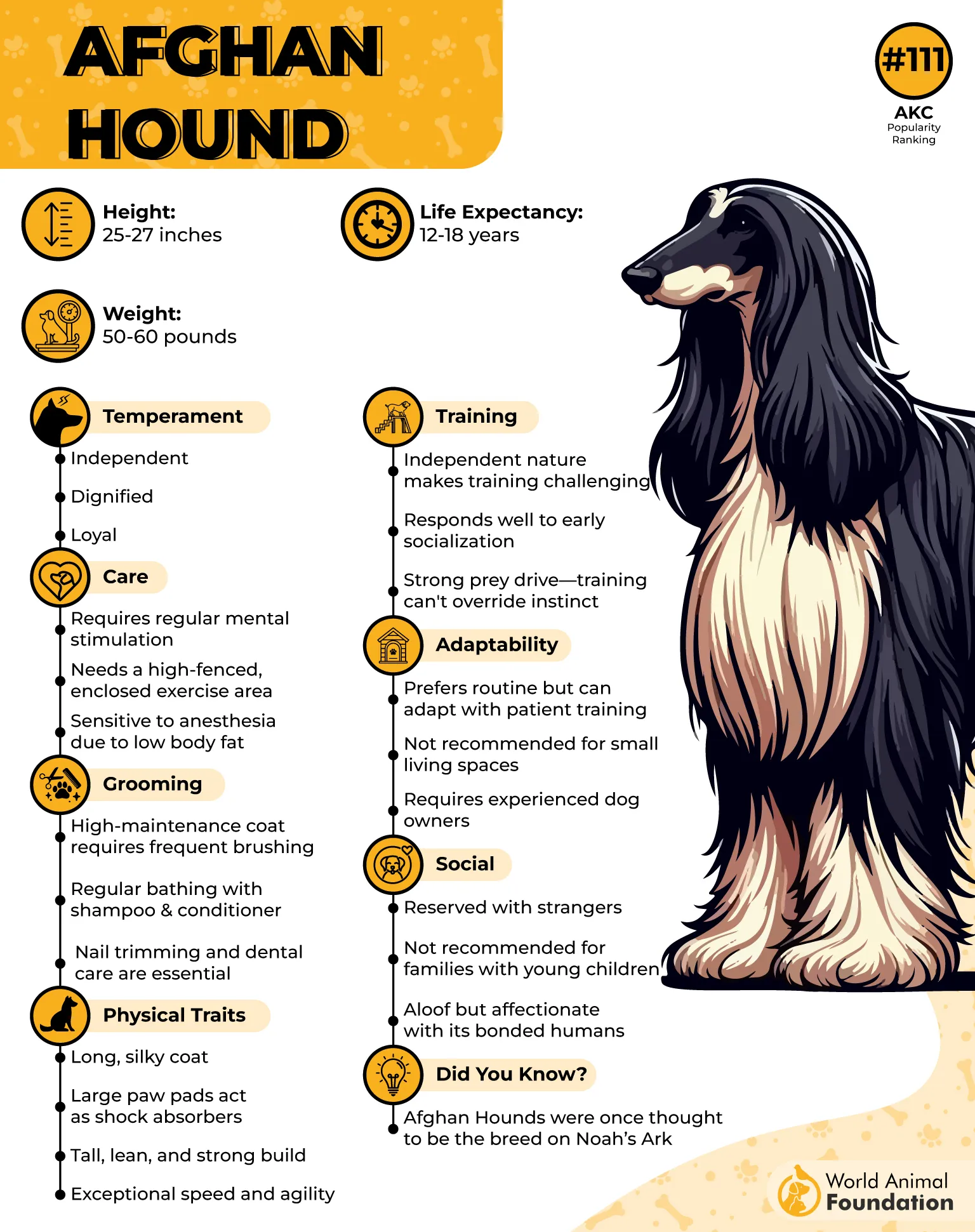
Grooming
Grooming an Afghan Hound is not for the faint of heart. Their long, fine coat requires regular bathing and thorough brushing to avoid matting. Before grooming, they should be bathed and then brushed from the skin outward, often with the aid of a grooming spray and blow dryer.
Pay special attention to problem areas like behind the ears and under the legs. Snoods are often used during meals to protect those luxurious ears from moisture and debris.
Fun fact: Barbie once had a glamorous Afghan Hound companion named Beauty, released by Mattel in 1981.
10. Cavalier King Charles Spaniel
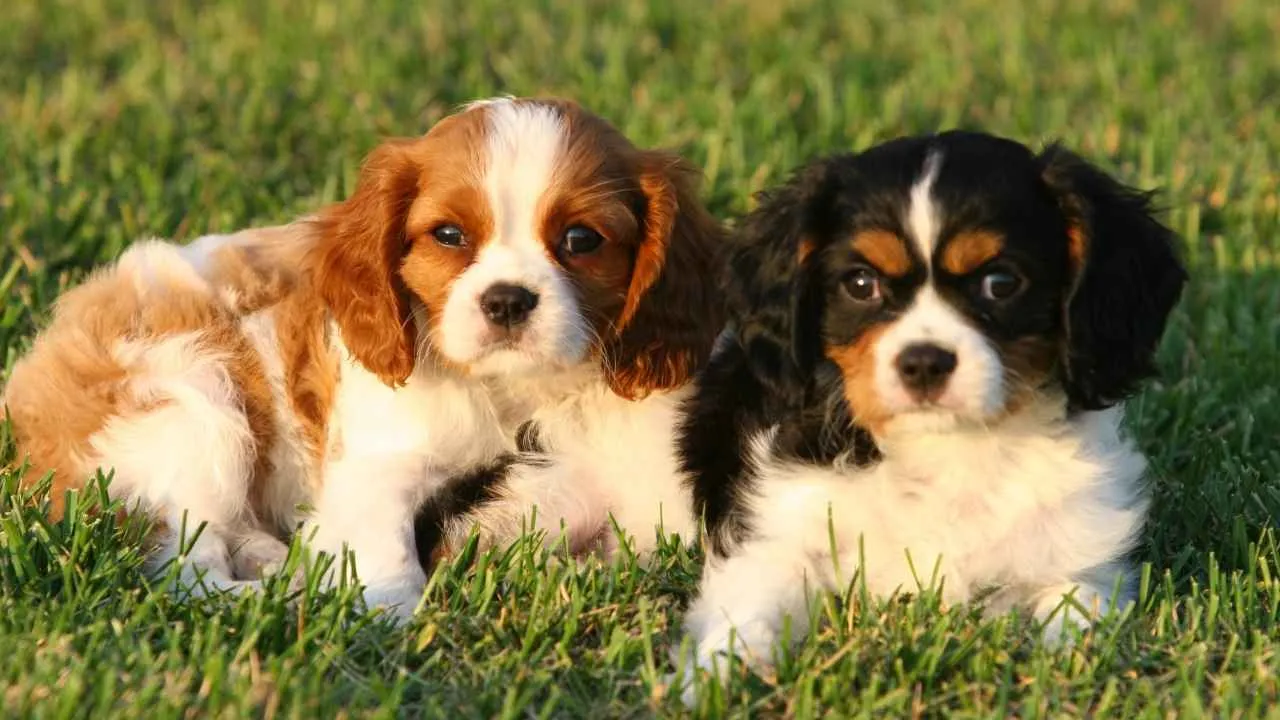
With roots tracing back to 17th-century European royalty, the Cavalier King Charles Spaniel—often nicknamed the “Cavvie”, is as noble in history as it is in appearance. Named for King Charles I and his son Charles II, who adored the breed, the Cavvie remains a favorite among dog lovers for its sweet temperament and signature silky, floppy ears.
These toy group dogs stand about 12 to 13 inches tall and typically weigh between 13 and 18 pounds. Despite their dainty stature, they’re athletic and adaptable, excelling in activities like agility and obedience. Their expressive eyes and affectionate nature make them treasured companions for families and individuals alike.
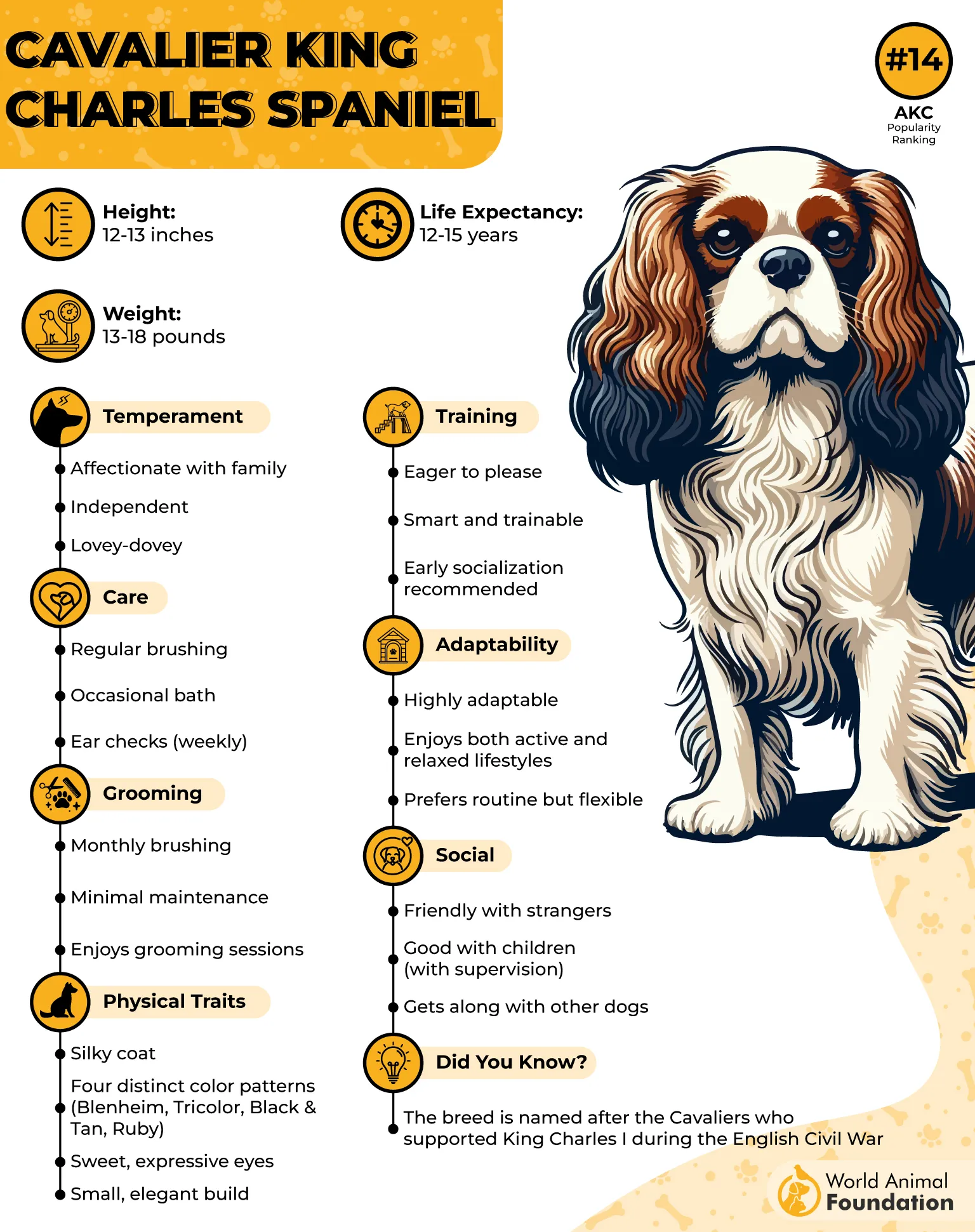
Grooming
The Cavalier’s long, fine coat requires consistent care to prevent matting and maintain its plush look. Begin grooming early to help them adjust to the process; many Cavaliers can be overwhelmed by noisy salons and unfamiliar tools. Regular brushing, light trimming, and conditioning keep their fur tidy and reduce ear-related issues like “glue ear,” a mucus blockage sometimes seen in this breed.
Fun fact: Cavaliers are known for their friendly nature and get along with everyone, dogs, cats, kids, and especially their humans.
Conclusion
Floppy-eared dog breeds captivate us not only with their adorable, droopy ears but also with the charm, personality, and history each one carries. From regal companions like the Cavalier King Charles Spaniel with their silky ears, to the Basset Hound and Bloodhound whose long lobes help trap scent, these breeds showcase a delightful blend of form and function. In fact, a dog’s ears can do more than just frame a sweet face; they can play a role in boosting the dog’s nose for scent detection, aiding in tracking and hunting.
Many floppy-eared breeds also rank among the most ancient dog breeds, their appearance and traits shaped over centuries of companionship, utility, and love. While some have historically served as hunters or lapdogs to nobility, today they’re beloved family members around the world. Whether you’re drawn to their elegance, their affectionate personalities, or their endearing expressions, one thing is certain: floppy-eared dogs have a timeless appeal that continues to win hearts.


